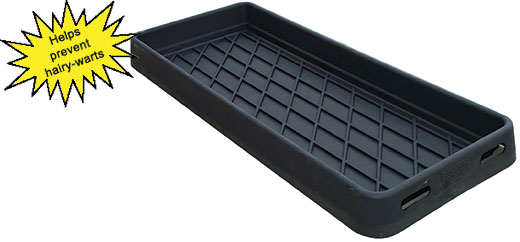POLY FOOTBATH
No wood frame needed - self-supporting.
Cross-rib, safety-grip bottom opens hooves wider ... for better penetration ... faster healing

- Quick and easy way to clean and disinfect cattle's feet
- Washing action of footbath removes damaging material from feet — helps prevent buildup of dirt and manure between cleats where harmful bacteria tends to harbor Disinfectant solution (copper sulfate mixed with water), kills or inhibits bacterial infections such as hairy-warts, foot-rot and heel erosion — penetrates up between toes and cracks (where bacteria inflames the soft skin), and then penetrates under the horn lining and inner surfaces of each cleat
- Disinfectant solution hardens the horn and toughens the skin in vital areas between cleats of the hoof. This drying effect on the hoof and skin makes cattle's feet more resistant to bacterial infection
- High-density, black, all poly — won't rust, rot, puncture or crack, even at extreme temperatures
- Thick-walled, seamless, one-piece units are extra-strong and leak-proof
Click the image below to enlarge

Click here to download this chart
Footbathing after milking is preferred, since chemicals tracked inside will corrode metals. Locate footbath by exit door of stall barn, or in the exit lane of milking parlor, so cows walk through it twice a day. Cows should leave footbath onto a dry, firm surface. Walking cows over a thin bed of lime after the footbath is also very beneficial. The lime acts as a backup to the footbath in keeping the skin over the heel areas hard and dry and provides good footing.
TIP: If your cows initially try to walk around or jump over footbath, fill it with hay. Gradually remove the hay over the next several days, until your cows are used to walking through the footbath.
Position so cows can not walk around it — close doors as needed.
Fill footbath with a 2-1/2% to 5% copper sulfate solution. Do not use concentrations greater than 5%, as they can harm skin on a cow's feet or may splash up on a cow's teats. Once existing foot problems have been reduced, cut solution percentage to 3% or 2-1/2%.
The footbath solution should be 3-1/2" to 6" deep. It should be emptied and cleaned thoroughly once a week, more often if it becomes diluted with waste (the strength of the solution will decrease during use, but copper sulfate is not quickly inactivated by manure. The appearance of the solution does not necessarily reflect its effectiveness). Most vets claim that the emptied solution should not cause contamination problems if it is added to barn manure waste.
Regular use of a footbath as a preventative treatment is very important. Use of a footbath only after the outbreak of clinical disease is not generally effective. Most vets recommend using footbath with disinfectant solution two times a day for at least two days per week. During the remainder of each week, they recommend filling the footbath daily with clean water so cows can walk through it at each milking.
